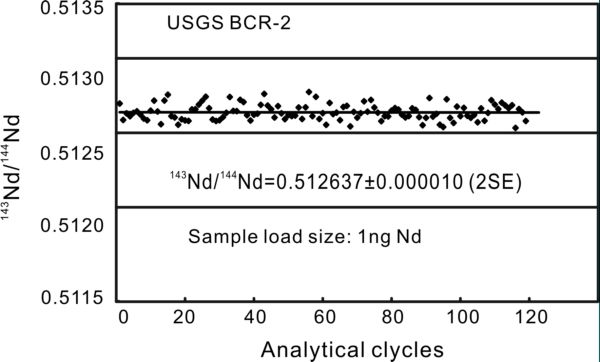Highlight 2009-041Update time:11 10, 2009
Journal of Analytical Atomic Spectrometry,2009, 24: 1534-1544 Precise determination of Sm, Nd concentrations and Nd isotopic compositions at the nanogram level in geological samples by thermal ionization mass spectrometry Zhuyin Chu, Fukun Chen, Yueheng Yang and Jinhui Guo Abstract
In this paper, a high sensitivity method for measurements of Nd isotopes as NdO+, on a TIMS using a single W filament with TaF5 as an ion emitter is presented. Although analyzing Nd isotopes as oxides (NdO+) is a well known technique, this is the first report to analyze Nd isotopic compositions as oxides using W filaments and the TaF5 emitter. When 0.5–1 ng loads of a Neodymium isotopic reference reagent, JNdi-1, were measured using this method, the ion yields were found to be mostly in excess of 15% and could be as high as 32%. Internal precision on 143Nd/144Nd could be better than 10 ppm (2SE) for 1 ng JNdi-1 loads and better than 15 ppm (2SE) for 0.5 ng JNdi-1 loads; thirteen replicates of 0.5–1 ng JNdi-1 loads yielded a 143Nd/144Nd value of 0.512112 ± 0.000028 (2SD). Compared with the previously reported NdO+ measurement method using the Re (or W) filaments + Silica-gel + H3PO4 loading techniques, this method has advantages including higher sensitivity, a more stable ion beam, and no need for oxygen gas to be bled into the ion source chamber. Sm isotopes were analyzed as Sm+ using the W filaments and the TaF5 emitter, and high sensitivity and good ion beam stability were also obtained. Several international rock reference materials, including an ultramafic rock reference material USGS PCC-1 that contains very low amounts of Sm and Nd, were analyzed with full column chemistry and the TaF5 method, and the results of Sm, Nd concentrations and Nd isotopic data are in good agreement with the reported values. Combined with a highly efficient and low-blank column chemistry to separate Nd from Sm, Ce, and Pr, this method holds potential to analyze Sm, Nd concentrations and Nd isotopic compositions of highly depleted peridotites; very small aliquots of minerals such as garnets; extra-terrestrial materials of limited sample size; and environmental samples that contain very low quantities of Sm and Nd.
|
Contact
Related Articles
Reference
|
-
SIMSSecondary Ion Mass Spectrometer Laboratory
-
MC-ICPMSMultiple-collector ICPMS Laboratory
-
EM & TEMElectron Microprobe and Transmission Electron Microscope Laboratory
-
SISolid Isotope Laboratory
-
StIStable Isotope Laboratory
-
RMPARock-Mineral Preparation and Analysis
-
AAH40Ar/39Ar & (U-Th)/He Laboratory
-
EMLElectron Microscopy Laboratory
-
USCLUranium Series Chronology Laboratory
-
SASeismic Array Laboratory
-
SEELaboratory of Space Environment Exploration Laboratory
-
PGPaleomagnetism and Geochronology Laboratory
-
BioMNSFrance-China Bio-mineralization and Nano-structure Laboratory

 Print
Print Close
Close
